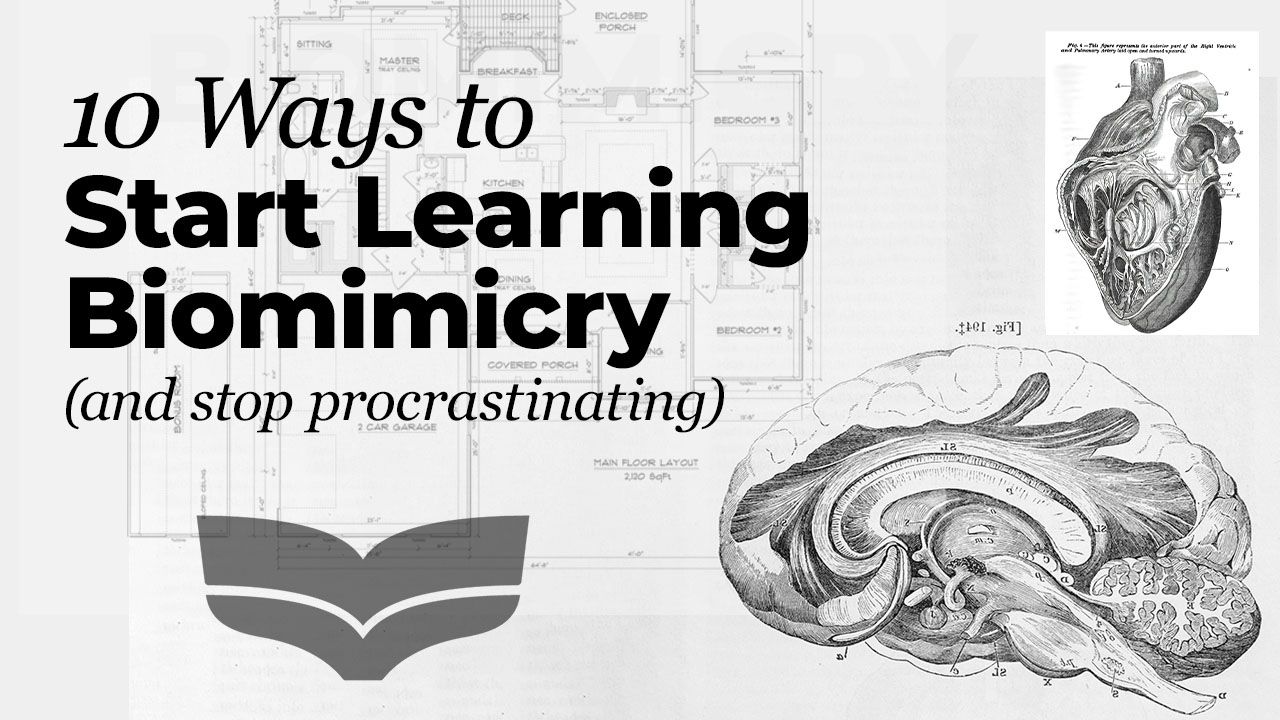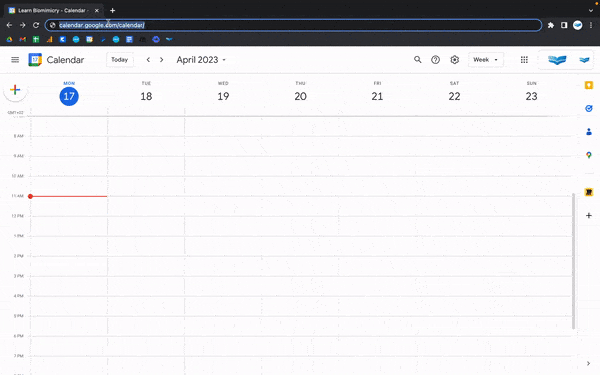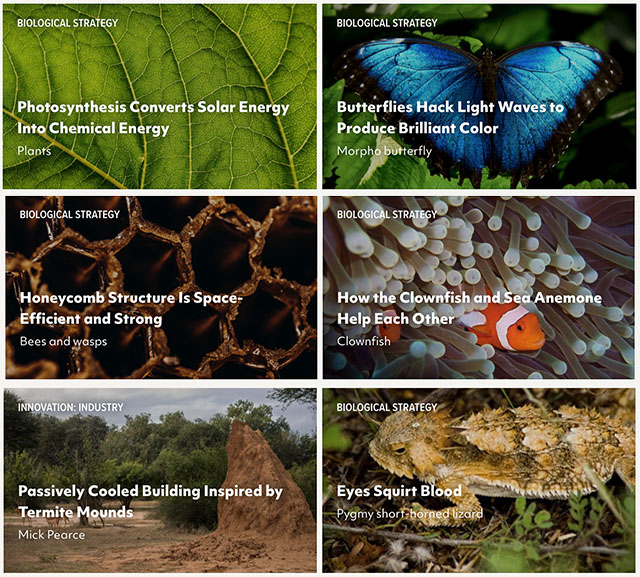10 Ways to Start Learning Biomimicry (and stop procrastinating)

When you are learning a new language, skill or practice, there are generally two key challenges that arise - either you are time constrained or intellectually challenged. The sweet spot (in learning and in life) is to find a challenge worth pursuing. Your challenge should be
1.) hard enough that you are indeed challenged, but
2.) not hard enough that you lose energy or momentum.
> The easiest way to start Learning Biomimicry? Sign up for our Biomimicry Short Course Set
In this article, we discuss the building of learning habits. Taking inspiration from the book Atomic Habits, there are five big ideas that are important to note here:
- Habits are the compound interest of self-improvement.
- If you want better results, then forget about setting goals. Focus on your system instead.
- The most effective way to change your habits is to focus not on what you want to achieve, but on who you wish to become.
- The Four Laws of Behavior Change is a simple set of rules we can use to build better habits. They are
- (1) make it obvious
- (2) make it attractive
- (3) make it easy, and
- (4) make it satisfying
- The environment is the invisible hand that shapes human behaviour.
With that said, here is the list of 10 ways you can start learning biomimicry (and stop procrastinating).
1. Make Learning a Daily Habit.
In short.. learn daily.
Habits are the compound interest of self-improvement.

Reference: Book Summaries - Atomic Habits
Learning daily offers numerous advantages over occasional learning. First, consistent daily learning promotes better retention and recall, as it reinforces neural connections in the brain… resulting in reinforced memory and understanding. Secondly, daily learning helps to build discipline and habits, critical for long-term success. When you commit to learning daily, you develop a routine that becomes ingrained in your daily life, making it easier to prioritize and consistently engage in learning activities. Third, daily learning allows for incremental progress, leading to a compounding improvement. Lastly, daily learning fosters a growth mindset, as it encourages a continuous process of improvement and self-motivation. In closing, daily learning enables you to make steady strides toward your learning goals, rather than relying on sporadic bursts of effort.
2. Set Aside Time in the Future
Head to your digital calendar and set aside 50 minutes to study. Preferably earlier in the day before the noise.
Tip - make the learning event repeat on specific days (or daily) to guarantee building your learning habit

Find an Accountability Partner
An accountability partner is someone who supports you, keeps you on track to your personal commitment, and helps to maintain progress towards your desired goal. This could be your spouse, trusted friend, fellow learner, or colleague, who you will regularly check in and update on your progress.
How to step this up:
- Identify an individual to be your accountability partner
- Reach out to them with a message saying
“Hey {{First Name}},
I'm really motivated to learn biomimicry. Would you be willing to be my accountability partner?
I could use your support by checking in with you <daily, weekly, monthly> via this thread to hold me accountable for my learning goals and keep me on track"
Regards,
{{Your Name}}
Looking to find an accountability partner that's already learning biomimicry? Feel free to reach out to us at [email protected] to find an accountability partner.
Make it Atomically Small 💣
Make it easy, and make it small. Small is beautiful… for so many reasons. Making your learning behaviour atomic, or breaking it down into small, manageable steps, is essential for building the habit of learning. Small behaviours are easier to initiate, are less intimidating and require less effort - making them more likely to be repeated consistently. By starting with tiny, achievable actions, such as dedicating just 5 minutes a day to learning, you can easily incorporate them into your routine without feeling overwhelmed.
Over time, these small behaviours accumulate and become automatic, ingrained habits that are much easier to maintain and sustain. Breaking down learning into atomic behaviours helps you build positive momentum and sets the foundation for long-term habit formation, leading to consistent and effective learning outcomes. Walk Slowly, But Never Backward.
Forget about setting goals. Focus on your system instead ⭕️
Instead of setting your goal to "learn this short course in X number of days," it's more effective to focus on developing a system for learning. Start by identifying specific, manageable behaviours that you can consistently incorporate into your daily or weekly routine,
Example of your system: I will allocate [5, 8 or 20] minutes each day in the [morning, midday, or evening] to sit at [your favourite reading spot] and [watch one video, read course material or review one handbook].
By prioritizing the system, you establish a framework that supports consistent learning habits, leading to continuous progress and improved skills over time.
Invite More Nature into Your Lifestyle 🐞
Biomimicry encourages a deep connection with nature, which can foster curiosity, wonder, and inspiration for learning FROM nature. My mother always used to say that ‘your best ideas happen when you’re watering the garden.’ By observing nature's strategies, you will develop a holistic understanding of how nature solves complex problems and apply those principles to your own learning process. Incorporating nature into your lifestyle encourages a hands-on, experiential approach to learning. Engaging in practical activities, such as observing natural systems, conducting field studies, or drawing biological solutions. These practices can deepen your understanding of the principles and practices of nature through real-world applications.
The Swiss engineer and outdoorsman George De Mestral got the idea for Velcro® from walking his dogs in the woods … it wasn’t the walk, but rather the walk and the curiosity to observe under a microscope, the burrs which stuck to his clothes. It’s no accident that the best biomimicry examples started by thinking outside.
Create Your Learning Environment 🍃🌱🌿🪴🌳
Create an environment where doing the right thing is as easy as possible. Your environment is the invisible hand that shapes your human behaviour.
i.e.) Leave your hiking shoes at the door the night before and before you know it, you’ll be heading outdoors.
Creating a conducive learning environment at home is crucial for effective learning. Establishing a learning routine asks one (or more) of the following
- choose a dedicated space
- keep your materials organized
- Set a reminder, such as a motivational sticky note on your computer the night before
- eliminate distractions, and
- personalize your space with nature-inspired wonders
Experiment with different strategies and find what works best for you to create an optimal learning environment at home.
Ask yourself - “Who is it I wish to be”
‘The most effective way to change your habits is to focus not on what you want to achieve, but on who you wish to become'
|
What I Wish to Achieve |
What I Wish to Become |
|
Complete a short course Lose weight Quit smoking etc. |
A lifelong and lifewide learner Health-conscious Fit and active Non-smoker etc. |
“The most effective form of learning is practice, not planning”
Consistently Ask Nature
Reference: AskNature
A regenerative future starts when we AskNature. Any biomimic worth her or his salt starts by asking 'what would nature do'. Today AskNature.org is the largest open-source database of biological strategies for sustainable innovation. AskNature bridges the knowledge gap that prevents problem solvers from looking to biology as a source for radically sustainable solutions. With nearly 2,000 expertly-curated strategies and counting, the site is an invaluable tool in the Biomimicry Institute's mission to make it possible for anyone, anywhere, to discover, learn, and practice biomimicry. Visit https://asknature.org/ to well ... ask nature anything
Start Where You Are
Biomimicry is a practice, meaning the more you do it, the better you get. The most effective form of learning is practice, not planning - so getting started is the most important step. It’s important to acknowledge that getting started isn’t easy, but it is worth it. Make it small as possible to get the ball rolling.
'Procastion is like a credit card… it’s a whole lot of fun … until you get the bill'
So with that said. Start wherever you are, and begin building your own learning habits. We’re here to guide you, enable you and support you along the way.
Wild regards
Alistair and the Learn Biomimicry team
Three more ways we can help you learn biomimicry
1.) Download our FREE eBook: A Field Guide to Biomimicry. Dive into the best of biomimicry in this introductory handbook. By engaging with summaries of key concepts, you’ll start to discover how nature’s lessons can be applied in your own life and career.
2.) Biomimicry Short Courses - Through these courses, you'll get practical knowledge of how to apply Biomimicry to your own design, get a learn biomimicry certificate which is recognized globally (and endorsed by the Biomimicry Institute), and so much more. Check out our Biomimicry Short Courses here today.
3.) If you have a project or idea and are looking to build it with Biomimicry in mind, join our 6-month Biomimicry Practitioner Programme to get hands-on with Nature.


